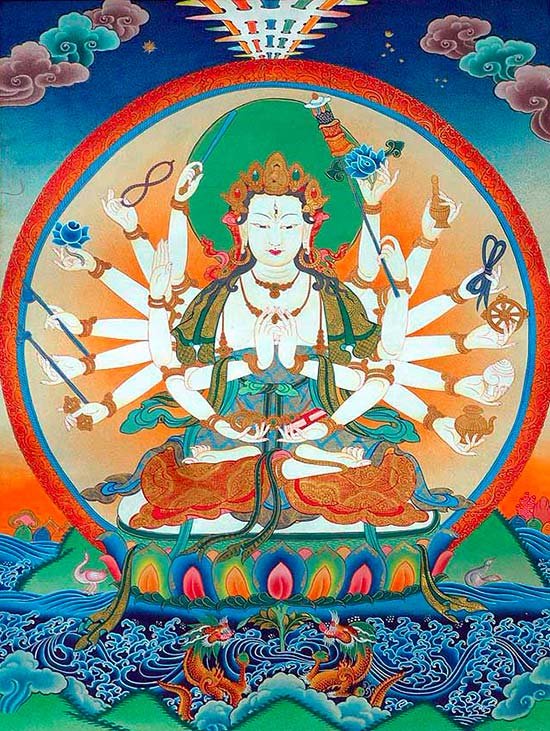Maha Prajnaparamita Sastra
by Gelongma Karma Migme Chödrön | 2001 | 941,039 words
This page describes “definition of bodhisattva” as written by Nagarjuna in his Maha-prajnaparamita-sastra (lit. “the treatise on the great virtue of wisdom”) in the 2nd century. This book, written in five volumes, represents an encyclopedia on Buddhism as well as a commentary on the Pancavimsatisahasrika Prajnaparamita.
Part 2 - Definition of Bodhisattva
Note: For this entire section, see the excellent article Bosatsu in Hôbôgirin, p. 136–142.
Question. – What do the words bodhi and sattva mean?
Answer. – 1. Bodhi is the path of the Buddhas (buddhamārga); sattva is either a being or a great mind.[1] The bodhisattva is the being who is going to obtain the mind, indestructible (aheya) and infrangible (acyuta) like a diamond mountain (vajraparvata), of the qualities (guṇa) of the Path of the Buddhas. Such is the great mind. Some stanzas say:
All the Buddha-attributes,
Wisdom (prajñā), discipline (śīla) and meditation (samādhi)
That are profitable to all
Are called ‘bodhi’.
The unshakeable (akṣobhya) mind,
Able to patiently accomplish the dharmas of the Path,
Indestructible (aheya) and infrangible (acyuta),
This mind is called ‘sattva’.
2. Furthermore, sat means to praise (stava) the holy Dharma, tva means the essential nature (bhāvalakṣaṇa) of the holy Dharma. The bodhisattva is so called because his mind is beneficial to himself and to others, because he saves all beings, because he knows the true nature (bhūtasvabhāva) of all dharmas, because he travels the Path of supreme perfect enlightenment (anuttarasamyaksaṃbodhi) and because he is praised by all the āryas. Why is that? Among all the attributes (dharma), that of the Buddha is foremost and because the bodhisattva wishes to attain it, he is praised by the āryas.
3. Furthermore, the bodhisattva is so called because he seeks to gain the Path in order to liberate all beings (sattva) from birth (jāti), old age (jarā) and death (marana).
4. Furthermore, three kinds of Paths (mārga) are called ‘bodhi’: i. the Path of the [86b] Buddhas, ii. the Path of the śrāvakas, iii, the Path of the pratyekabuddhas. That of the pratyekabuddhas and of the śrāvakas, while leading to a bodhi, are not, however, qualified as bodhi. But the bodhi contained in the qualities of Buddha (buddhaguṇa) are qualified as Bodhi. This is what is called ‘bodhisattva’.
Question. – For how many reasons is he called Bodhisattva?
Answer. – The Bodhisattva is so called for three reasons: he possesses the great vow (mahāpraṇidhāna), his mind (citta) is unshakeable (acala, akṣobhya) and his energy (vīrya) is irreversible (avaivartika).
Furthermore, some say that he is called Bodhisattva starting from the first production of the mind of bodhi (prathamacittotpāda), when he made the vow to become Buddha and to save all beings. A stanza says:
When, at the moment of the first cittotpāda,
He made the vow to become Buddha,
He has surpassed all the universes
And is worthy to be venerated (pūjā) by men.
He is called Bodhisattva during the interval [of time] starting from the first production of mind (prathamacittotpāda) up to the ninth uninterrupted path (ānantarya) when he enters into the diamond concentration (vajrasamādhi).[2]
Footnotes and references:
[1]:
The same interpretation of sattva as ‘mind’ in various Chinese commentaries cited by the Bukkyo daijiten, p. 1626, and by Hôbôgirin, p.139, which refers to T 1521, k. 2; T 1575, k. 1, T 1718, k. 2. – There is also a good definition of bodhisattva-mahāsattva in the Buddhabhūmiśāstra, T 1530, k. 2, p. 300a.
[2]:
The ninth ānantarya causes the abandonment of the ninth category of afflictions of the bhavāgra; as it breaks all the anuśayas, it receives the name ‘concentration like a diamond’ (vajropamisamādhi). – The vajropamisamādhi is attained by the bodhisattva in the tenth bhūmi, at the end of the stage of meditation (bhāvanāvastha); he cuts the last obstacles (āvaraṇa) on the path. Immediately following it (hence its name ānantarya), the bodhisattva undergoes the revolution of the support (aśrayaparāvṛtti), realizes mahānirvāṇa and mahābodhi and enters onto the Buddha level. On this subject which demands lengthy development, I [Lamotte] will limit myself to providing a few references: Kośa, IV, p. 231; VI, p. 190, 228–229, 264, 300; VII, p. 62; VIII, p. 192, 195; E. Obermiller, Doctrine of P. P., p. 44; Uttaratantra, p. 223; Bodh. bhūmi. p. 403; Sūtrālaṃkāra, XIV, v. 45; Madhyāntavibhaṅga, p. 83, 157; Saṃgraha, p. 273; Siddhi, p. 3, 162, 563, 611, 653, 667, 685.
